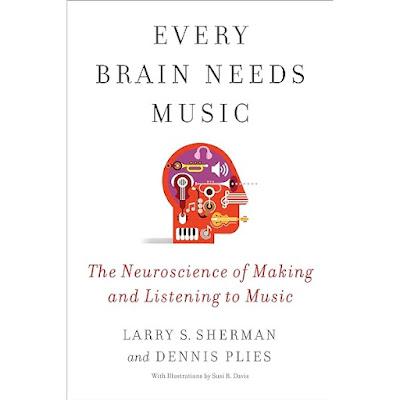
Every Brain Needs Music: The Neuroscience of Making and Listening to Music. Larry S. Sherman and Dennis Plies. 2023. Columbia University Press. [ISBN 978- 0-231-20910-6. 270 pages, including index. US 32.00 (hardcover).]
Every Brain Needs Music: The Neuroscience of Making and Listening to Music is the compilation of a musical neuroscience collaboration—a synopsis of what science knows and does not yet know about how making, practicing, performing, listening, and learning music affects the brain. And beyond that, how those effects spill over into the human experience.
The book’s layout attracts the musical reader with its orchestra labels. The introduction is a “Prelude” followed by an “Overture,” a short summary of the book. Each subsequent chapter is labeled with a numerical “movement.” Music lovers will delight at the final chapter, “Coda,” knowing that the coda of a song is a short ending following one or more repeated sections.
The first “movement” begins with a detailed description of basic neuroscience. This includes the most common method of studying the active mind—a procedure called functional magnetic resonance (fMRI). It is very similar to a regular MRI but specific for the brain; it “detects the changes in the flow of blood through tiny vessels in different regions of the brain and changes in blood oxygenation, which represent changes in neuronal activity” (p. 11).
Many of the preliminary results discussed are based on fMRI studies—flawed as it is as a measure of brain activity. One significant discovery with this technique is that music alone (not other sounds) triggers specific areas of the brain. This could redefine what music is from a neuroscience perspective. Also considered was a qualitative survey taken of professional musicians of all types with the results being compiled into general trends within bar graphs included in Appendix A.
The other “movements” (chapters of this book) on practicing, performing, and listening are most relevant to many readers while the “movements” on improvising and composing pertain to a smaller percentage of their audience. All chapters discuss specific studies related to a comparison of music type and how fMRI results (or similar PET scanning) differ and how those results might be interpreted.
All readers who have ever practiced and performed music at any level can relate with the statement, “Mastering a piece can be an ongoing process of unfolding its meaning, in terms of both personal expression and the composer’s intention. It’s a search. It’s never boring, but always challenging in positive ways, for music holds poetic space” (p. 70).
Overall, this collaborative book presents a thorough synopsis of current musical neuroscience research. Unfortunately, much of it is still in the infancy stage as current technology only allows us to surmise connections between brain parts. The specific mechanisms and interchanges beyond the basic neuron level are not yet understood on a chemical level.
In the “Coda,” Larry Sherman states, “I’m struck by the amount of computational power it takes to perceive and respond to music and the fact that we still have much to learn about the underlying circuitry involved in how sound is processed in the auditory cortex before traveling to other areas of the brain” (p. 198). This coda is perhaps the prelude to yet another set of movements to be written when this is discovered.
Julie Kinyoun
Julie Kinyoun is an on-call chemistry instructor at various community colleges in Southern California. An avid reader, she enjoys reviewing books that help her become a better educator.
